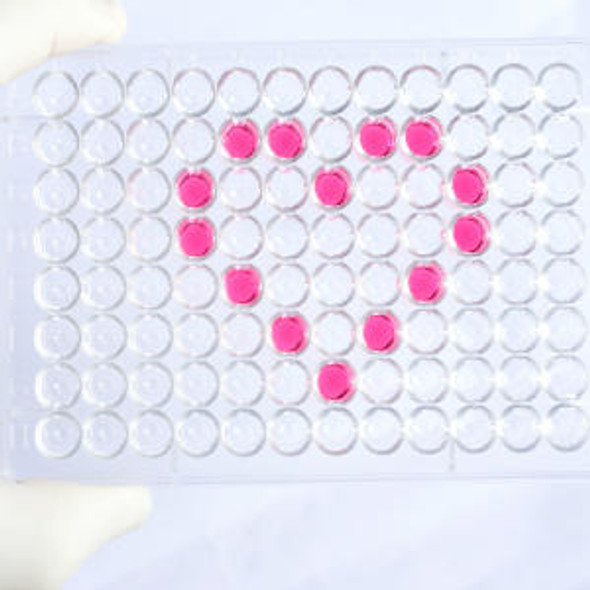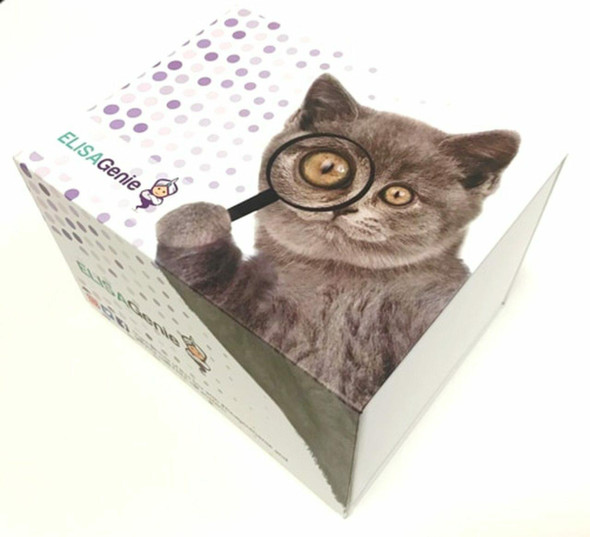Human Epigenetics and Nuclear Signaling ELISA Kits
Human PA2G4 (Proliferation Associated Protein 2G4) CLIA Kit (HUES00523)
- SKU:
- HUES00523
- Product Type:
- ELISA Kit
- ELISA Type:
- CLIA Kit
- Size:
- 96 Assays
- Sensitivity:
- 37.5pg/mL
- Range:
- 62.5-4000pg/mL
- ELISA Type:
- Sandwich
- Reactivity:
- Human
- Sample Type:
- Serum, plasma and other biological fluids
- Research Area:
- Epigenetics and Nuclear Signaling
Description
| Assay type: | Sandwich |
| Format: | 96T |
| Assay time: | 4.5h |
| Reactivity: | Human |
| Detection method: | Chemiluminescence |
| Detection range: | 62.50-4000 pg/mL |
| Sensitivity: | 37.50 pg/mL |
| Sample volume: | 100µL |
| Sample type: | Serum, plasma and other biological fluids |
| Repeatability: | CV < 15% |
| Specificity: | This kit recognizes Human PA2G4 in samples. No significant cross-reactivity or interference between Human PA2G4 and analogues was observed. |
This kit uses Sandwich-CLIA as the method. The micro CLIA plate provided in this kit has been pre-coated with an antibody specific to Human PA2G4. Standards or samples are added to the appropriate micro CLIA plate wells and combined with the specific antibody. Then a biotinylated detection antibody specific for Human PA2G4 and Avidin-Horseradish Peroxidase (HRP) conjugate are added to each micro plate well successively and incubated. Free components are washed away. The substrate solution is added to each well. Only those wells that contain Human PA2G4, biotinylated detection antibody and Avidin-HRP conjugate will appear fluorescence. The Relative light unit (RLU) value is measured spectrophotometrically by the Chemiluminescence immunoassay analyzer. The RLU value is positively associated with the concentration of Human PA2G4. The concentration of Human PA2G4 in the samples can be calculated by comparing the RLU of the samples to the standard curve.
| UniProt Protein Function: | Ebp1: May play a role in a ERBB3-regulated signal transduction pathway. Seems be involved in growth regulation. Acts a corepressor of the androgen receptor (AR) and is regulated by the ERBB3 ligand neuregulin-1/heregulin (HRG). Inhibits transcription of some E2F1-regulated promoters, probably by recruiting histone acetylase (HAT) activity. Binds RNA. Associates with 28S, 18S and 5. 8S mature rRNAs, several rRNA precursors and probably U3 small nucleolar RNA. May be involved in regulation of intermediate and late steps of rRNA processing. May be involved in ribosome assembly. Mediates cap-independent translation of specific viral IRESs (internal ribosomal entry site). Belongs to the peptidase M24 family. |
| UniProt Protein Details: | Protein type:Nucleolus; Transcription, coactivator/corepressor; Nuclear receptor co-regulator Chromosomal Location of Human Ortholog: 12q13. 2 Cellular Component: nucleoplasm; membrane; cytoplasm; nucleolus; nucleus; ribonucleoprotein complex Molecular Function:protein binding; DNA binding; ubiquitin protein ligase binding; transcription factor activity Biological Process: regulation of translation; cell proliferation; transcription, DNA-dependent; negative regulation of transcription, DNA-dependent; positive regulation of cell differentiation; cell cycle arrest; rRNA processing; negative regulation of apoptosis |
| NCBI Summary: | This gene encodes an RNA-binding protein that is involved in growth regulation. This protein is present in pre-ribosomal ribonucleoprotein complexes and may be involved in ribosome assembly and the regulation of intermediate and late steps of rRNA processing. This protein can interact with the cytoplasmic domain of the ErbB3 receptor and may contribute to transducing growth regulatory signals. This protein is also a transcriptional co-repressor of androgen receptor-regulated genes and other cell cycle regulatory genes through its interactions with histone deacetylases. This protein has been implicated in growth inhibition and the induction of differentiation of human cancer cells. Six pseudogenes, located on chromosomes 3, 6, 9, 18, 20 and X, have been identified. [provided by RefSeq, Jul 2008] |
| UniProt Code: | Q9UQ80 |
| NCBI GenInfo Identifier: | 13632817 |
| NCBI Gene ID: | 5036 |
| NCBI Accession: | Q9UQ80. 3 |
| UniProt Secondary Accession: | Q9UQ80,O43846, Q9UM59, |
| UniProt Related Accession: | Q9UQ80 |
| Molecular Weight: | 394 |
| NCBI Full Name: | Proliferation-associated protein 2G4 |
| NCBI Synonym Full Names: | proliferation-associated 2G4, 38kDa |
| NCBI Official Symbol: | PA2G4 |
| NCBI Official Synonym Symbols: | EBP1; HG4-1; p38-2G4 |
| NCBI Protein Information: | proliferation-associated protein 2G4; erbB3-binding protein 1; ErbB-3 binding protein 1; ErbB3-binding protein Ebp1; cell cycle protein p38-2G4 homolog; proliferation-associated 2G4, 38kD |
| UniProt Protein Name: | Proliferation-associated protein 2G4 |
| UniProt Synonym Protein Names: | Cell cycle protein p38-2G4 homolog; hG4-1; ErbB3-binding protein 1 |
| Protein Family: | Proliferation-associated protein |
| UniProt Gene Name: | PA2G4 |
| UniProt Entry Name: | PA2G4_HUMAN |
As the RLU values of the standard curve may vary according to the conditions of the actual assay performance (e. g. operator, pipetting technique, washing technique or temperature effects), the operator should establish a standard curve for each test. Typical standard curve and data is provided below for reference only.
| Concentration (pg/mL) | RLU | Average | Corrected |
| 4000 | 57755 60407 | 59081 | 59046 |
| 2000 | 27839 27879 | 27859 | 27824 |
| 1000 | 14099 12869 | 13484 | 13449 |
| 500 | 6294 6916 | 6605 | 6570 |
| 250 | 3304 3182 | 3243 | 3208 |
| 125 | 1683 1479 | 1581 | 1546 |
| 62.50 | 751 759 | 755 | 720 |
| 0 | 34 36 | 35 | -- |
Precision
Intra-assay Precision (Precision within an assay): 3 samples with low, mid range and high level Human PA2G4 were tested 20 times on one plate, respectively.
Inter-assay Precision (Precision between assays): 3 samples with low, mid range and high level Human PA2G4 were tested on 3 different plates, 20 replicates in each plate.
| Intra-assay Precision | Inter-assay Precision | |||||
| Sample | 1 | 2 | 3 | 1 | 2 | 3 |
| n | 20 | 20 | 20 | 20 | 20 | 20 |
| Mean (pg/mL) | 207.74 | 374.85 | 1516.52 | 190.92 | 361.00 | 1608.16 |
| Standard deviation | 22.31 | 41.31 | 128.90 | 19.74 | 34.55 | 172.07 |
| C V (%) | 10.74 | 11.02 | 8.50 | 10.34 | 9.57 | 10.70 |
Recovery
The recovery of Human PA2G4 spiked at three different levels in samples throughout the range of the assay was evaluated in various matrices.
| Sample Type | Range (%) | Average Recovery (%) |
| Serum (n=5) | 96-110 | 102 |
| EDTA plasma (n=5) | 87-102 | 94 |
| Cell culture media (n=5) | 88-99 | 93 |
Linearity
Samples were spiked with high concentrations of Human PA2G4 and diluted with Reference Standard & Sample Diluent to produce samples with values within the range of the assay.
| Serum (n=5) | EDTA plasma (n=5) | Cell culture media (n=5) | ||
| 1:2 | Range (%) | 96-109 | 91-106 | 85-97 |
| Average (%) | 102 | 97 | 91 | |
| 1:4 | Range (%) | 102-118 | 99-114 | 100-112 |
| Average (%) | 110 | 105 | 106 | |
| 1:8 | Range (%) | 95-107 | 89-102 | 99-114 |
| Average (%) | 101 | 95 | 105 | |
| 1:16 | Range (%) | 100-112 | 97-112 | 99-113 |
| Average (%) | 105 | 104 | 106 |
An unopened kit can be stored at 4°C for 1 month. If the kit is not used within 1 month, store the items separately according to the following conditions once the kit is received.
| Item | Specifications | Storage |
| Micro CLIA Plate(Dismountable) | 8 wells ×12 strips | -20°C, 6 months |
| Reference Standard | 2 vials | |
| Concentrated Biotinylated Detection Ab (100×) | 1 vial, 120 µL | |
| Concentrated HRP Conjugate (100×) | 1 vial, 120 µL | -20°C(shading light), 6 months |
| Reference Standard & Sample Diluent | 1 vial, 20 mL | 4°C, 6 months |
| Biotinylated Detection Ab Diluent | 1 vial, 14 mL | |
| HRP Conjugate Diluent | 1 vial, 14 mL | |
| Concentrated Wash Buffer (25×) | 1 vial, 30 mL | |
| Substrate Reagent A | 1 vial, 5 mL | 4°C (shading light) |
| Substrate Reagent B | 1 vial, 5 mL | 4°C (shading light) |
| Plate Sealer | 5 pieces | |
| Product Description | 1 copy | |
| Certificate of Analysis | 1 copy |
- Set standard, test sample and control (zero) wells on the pre-coated plate and record theirpositions. It is recommended to measure each standard and sample in duplicate. Note: addall solutions to the bottom of the plate wells while avoiding contact with the well walls. Ensuresolutions do not foam when adding to the wells.
- Aliquot 100µl of standard solutions into the standard wells.
- Add 100µl of Sample / Standard dilution buffer into the control (zero) well.
- Add 100µl of properly diluted sample (serum, plasma, tissue homogenates and otherbiological fluids. ) into test sample wells.
- Cover the plate with the sealer provided in the kit and incubate for 90 min at 37°C.
- Aspirate the liquid from each well, do not wash. Immediately add 100µL of BiotinylatedDetection Ab working solution to each well. Cover the plate with a plate seal and gently mix. Incubate for 1 hour at 37°C.
- Aspirate or decant the solution from the plate and add 350µL of wash buffer to each welland incubate for 1-2 minutes at room temperature. Aspirate the solution from each well andclap the plate on absorbent filter paper to dry. Repeat this process 3 times. Note: a microplatewasher can be used in this step and other wash steps.
- Add 100µL of HRP Conjugate working solution to each well. Cover with a plate seal andincubate for 30 min at 37°C.
- Aspirate or decant the solution from each well. Repeat the wash process for five times asconducted in step 7.
- Add 100µL of Substrate mixture solution to each well. Cover with a new plate seal andincubate for no more than 5 min at 37°C. Protect the plate from light.
- Determine the RLU value of each well immediately.






